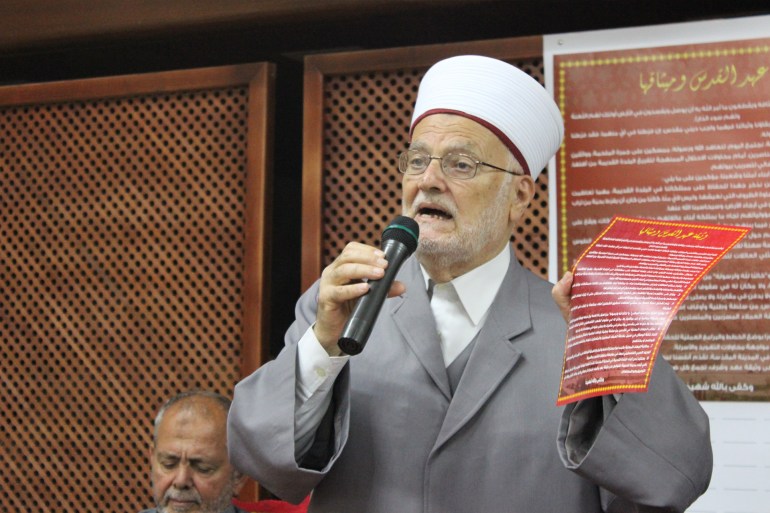“Al-Aqsa was burned, Al-Aqsa was burned.” On these calls, Sheikh Daoud Atallah woke up on the morning of August 21, 1969, and ran out from his house in Silwan towards Al-Aqsa Mosque. He entered the mosque through the Mughrabi Gate, and began to pass water and soil to extinguish the fire that had caught Inside the Al-Qibli prayer hall and came to a third.
On that day, Atallah was planning to go to Al-Aqsa to perform his task as a reader of the Qur’an in it, but his mission turned to extinguishing the fire and helping hundreds of Palestinians who closed their shops in the Old City and brought water from their homes, after the occupation cut off water from Al-Aqsa Mosque and obstructed the arrival of firefighting crews that were launched From Ramallah, Hebron and Bethlehem.
“We were like crazy, pouring water and crying,” Atallah told Al-Jazeera Net, then the crying lost his voice, gathered strength and continued, “You reminded me of a fateful day, the day Al-Aqsa was burned and Muslims abandoned their religion, and Islam,” then he cried again.
51 years have passed since the memory of the fire, but Atallah weeps to this day after he reached the age of 93, as he was a conscious man at the time of forty years of age, and scenes and pains were engraved in his mind, but today he sits at the scene of the fire and reads the Qur’an as he used to 68 years ago.
Not individual work!
On the day of the fire, and instead of Professor Ikrimah Sabri going to the Al-Aqsa Mosque to teach at Al-Aqsa Islamic High School, he intended to put out the fire, at that time he was thirty years old and rushed from his home in Wadi Al-Jouz running around him, men, women, children and the elderly around him, and when he arrived at the mosque, he found no time to catch his breath after He saw a strong flame emanating from the Al-Qibli prayer hall.
From hand to hand, Sabri transferred dirt and water with the masses of Palestinians, who were cheering and growing up and crying, and their voices rose and their heart beat quickened as the glow of the flame increased, as the fire came to the ceiling of the southern prayer hall made of wood and lead, and burned the entire eastern side, in addition to the dome and the minbar of Noor Al-Din Zangi or Saladin al-Ayyubi, and the mihrab adjacent to it, windows, carpets, Qur’ans, and vaults.
At the time, the Israeli occupation claimed that an electrical contact caused the fire, but it was later found that an Australian man named Michael Rohan orchestrated the fire and caused it through highly flammable materials. Sabri tells Al-Jazeera Net that it is not available in the market and only countries own it. The occupation arrested Rohan and claimed that he was mentally unstable and exiled To his country and then closed the file without return.
The first sermon after the fire
was the fire on Thursday, so the Friday sermon was not held in the Al-Qibli prayer hall, but the sermon was resumed on the following Friday, specifically on August 29, and Sabri says that his father, the preacher of Al-Aqsa Sheikh Saeed Sabri, delivered the sermon at the time standing on the ground, to burn the minbar, and mixing His voice wept from grieving worshipers, amid the blackness and dilapidated building.
Today, Sheikh Ikrimah Sabri is 81 years old, and he has been an imam and preacher in the Al-Aqsa Mosque for many years. He tells Al-Jazeera Net that his father was the last to sermon on the Zangi pulpit before it was burned. On the recommendation of the Hashemite Kingdom of Jordan. "
Sheikh Yusef Abu Sneina was 11 years old on the day of the fire, and he remembered well how he ran with his family and neighbors from the Old City towards Al-Aqsa and contributed to extinguishing the fire, which he says has not been extinguished until today, so his situation today is much more difficult than his situation 51 years ago.
Abu Sneina realized that one of the goals of burning the al-Aqsa minbar was to silence the word of truth. He and his peers.
Abu Sneina told Al-Jazeera Net, "My mission is very difficult. I must say the word of truth, whatever the circumstances. The occupation silences all voices by force. We were seven preachers and today three, after the occupation was removed from the rest of us. We must protect the pulpit from moral burning, not only material, by perpetuating the word of truth." from him".
It has not been extinguished until today.
The young Hamza Qattinah (29 years) from the Old City of Jerusalem did not witness the burning of the al-Qibli prayer hall, but the memory remained present in his mind through the testimonies of his family and acquaintances, and the stories transmitted to the generations in Jerusalem.
And by virtue of Qatinah's work as a Jerusalemite lawyer, he closely examines the occupation’s violations against Al-Aqsa, Jerusalem and their people, and tells Al-Jazeera Net that the scenes of fire are repeated daily in various forms through incursions, restrictions, control of doors and the removal of worshipers.
And he concludes, "I do not exaggerate if I say that burning my house is easier for me than burning Al-Aqsa Mosque, for touching it is a red line that we do not tolerate, and protecting it is an innate religious matter, for it is our most precious possession, and we license every precious thing in defense of it."

